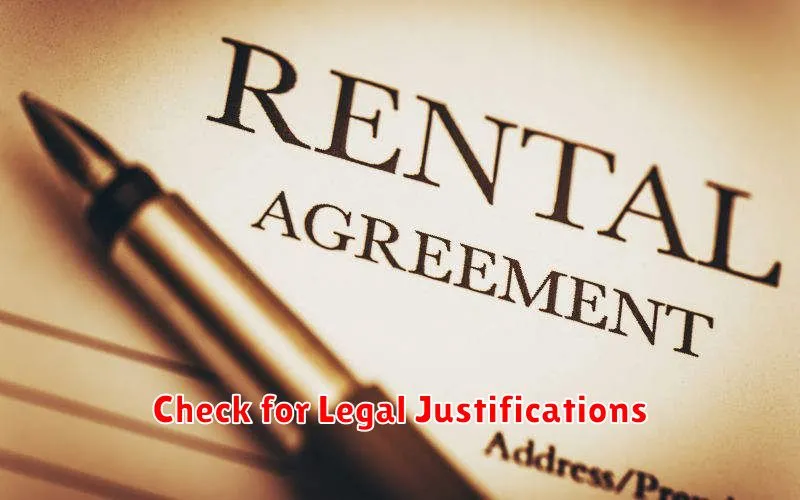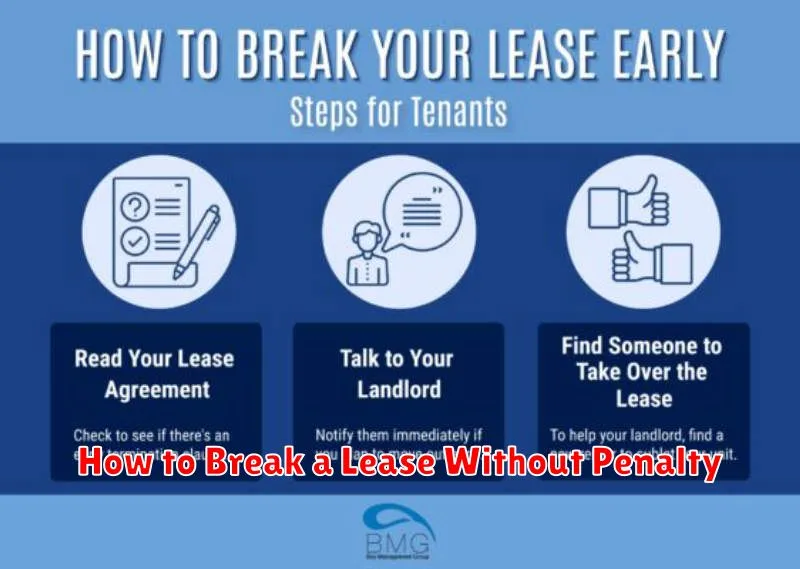Breaking a lease can be a complex and often costly endeavor. Many renters find themselves needing to vacate their rental property before their lease term expires due to unforeseen circumstances, such as job relocation, family emergencies, or changes in financial situations. However, terminating a lease early typically involves penalties, including owing the remaining rent balance, forfeiting your security deposit, or facing legal action. This article will explore legitimate strategies for how to break a lease without penalty, allowing you to navigate this challenging process successfully and avoid significant financial burdens. Understanding your rights and responsibilities as a tenant is crucial to minimizing the negative consequences of breaking your lease. Learn how to effectively communicate with your landlord, explore potential lease clauses that may offer solutions, and discover how to protect yourself from unwanted fees and legal repercussions.
Breaking a lease agreement doesn’t have to be a stressful and expensive ordeal. While understanding the terms of your lease is paramount, there are often legitimate avenues to pursue when you need to break your lease without penalty. Whether it’s negotiating with your landlord, finding a suitable replacement tenant, invoking military clauses, or exploring legal justifications such as uninhabitable living conditions, proactive steps can be taken to mitigate the financial impact. This guide will equip you with the knowledge and strategies necessary to navigate the complexities of breaking a lease, empowering you to protect your financial interests and transition smoothly to your next living situation. We will delve into practical tips for negotiating with your landlord, understanding your state’s laws regarding lease termination, and preparing for all possible outcomes. By following the advice outlined in this article, you can significantly increase your chances of breaking your lease without penalty and avoiding the potential financial pitfalls.
Review the Lease Terms Carefully
The first step in potentially breaking your lease without penalty is to thoroughly review your lease agreement. Understanding the terms and conditions outlined in your lease is crucial. Look for specific clauses related to early termination.
Some leases include a buyout clause, specifying an amount you must pay to break the lease. This clause may outline a specific formula for calculating the buyout amount. Other leases may offer an early termination clause outlining specific conditions under which you can break the lease without penalty, such as job relocation or military service. Note any required notice periods for exercising these options.
Pay close attention to clauses regarding subletting or finding a replacement tenant. These options could allow you to transfer your lease obligations to another individual, relieving you of responsibility for the remaining lease term. Understand the process outlined in your lease for exercising these rights, including any requirements for approval by the landlord.
Check for Legal Justifications

Before considering breaking your lease, carefully review your lease agreement for any clauses that permit early termination without penalty. Some leases include clauses addressing specific situations like military deployment or job relocation. Thoroughly understand your lease terms as they dictate your rights and responsibilities.
Several legally justifiable reasons might allow you to break a lease without penalty. These typically fall under the following categories:
- Uninhabitable Conditions: If the property becomes uninhabitable due to landlord negligence in addressing necessary repairs, like a broken heating system during winter, you may have grounds to break the lease. Document these issues meticulously.
- Landlord Breach of Contract: If the landlord violates a substantial term of the lease, like failing to provide promised amenities or entering your unit without proper notice, you might have legal recourse to break the lease.
- Domestic Violence: Many states have laws protecting victims of domestic violence, allowing them to break a lease without penalty upon providing proper documentation.
- Active Military Duty: The Servicemembers Civil Relief Act (SCRA) provides protections for active-duty military members, allowing them to terminate a lease without penalty under specific circumstances.
Consult with a legal professional or your local tenant’s rights organization to determine if your situation qualifies as a legal justification for breaking your lease without penalty. They can advise you on the specific laws in your jurisdiction and the necessary steps to take.
Communicate Early with the Landlord
Initiating a conversation with your landlord as soon as you anticipate the need to break your lease is crucial. Open communication demonstrates good faith and increases the likelihood of reaching a mutually agreeable solution. Explain your situation clearly and honestly. Provide a concrete move-out date if possible.
Early notification gives your landlord more time to find a replacement tenant, reducing their potential financial losses. This proactive approach strengthens your position and may make them more receptive to negotiating a lease break without penalty.
Review your lease agreement thoroughly for specific clauses related to early termination. Be prepared to discuss these clauses with your landlord. Understanding the terms of your lease is essential for navigating this process effectively.
Find a Replacement Tenant
One of the most effective ways to break a lease without penalty is to find a replacement tenant yourself. This involves locating a qualified individual who is willing to take over your lease agreement for the remainder of its term.
Start early. Don’t wait until the last minute to begin your search. The more time you have, the better your chances of finding a suitable replacement.
Advertise your unit. Utilize online platforms, social media, and community bulletin boards to reach potential tenants. Be sure to include key details about the property, such as the rent price, lease terms, and available amenities.
Screen potential tenants carefully. Request applications and conduct thorough background and credit checks to ensure they meet the landlord’s criteria. This helps protect you from future liability.
Once you find a suitable candidate, present them to your landlord for approval. Provide all necessary documentation, such as the completed application and screening reports.
Get the Agreement in Writing
Once you’ve negotiated an agreement with your landlord to break your lease without penalty, it’s crucial to get it in writing. A verbal agreement, while potentially valid, is extremely difficult to enforce.
This written agreement should clearly state the terms of the lease termination, including:
- The date the lease will terminate.
- The amount, if any, you are required to pay.
- Responsibilities regarding advertising for a new tenant, if applicable.
- Confirmation that you will be released from all future obligations under the lease.
A written agreement protects both you and your landlord, preventing future disputes and misunderstandings. It serves as essential documentation should any legal issues arise.

